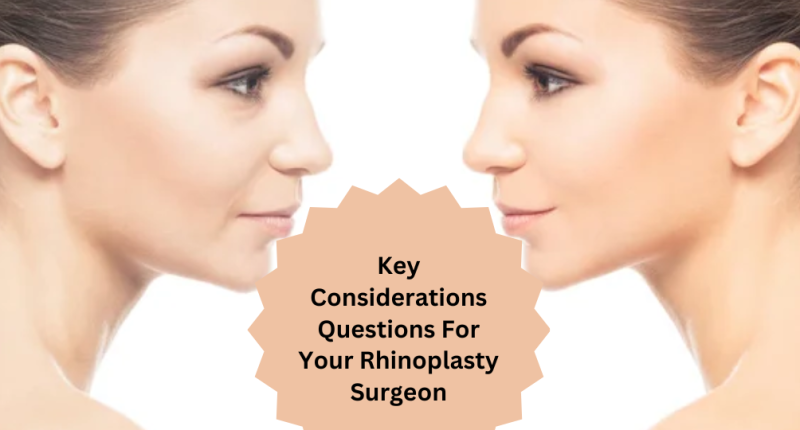Ask these Key Considerations Before And After Rhinoplasty: Questions to Ask Your Doctor – Embarking on the journey of rhinoplasty prompts a series of crucial questions that pave the way for an informed and satisfactory experience. Prior to delving into the transformative realm of this procedure, it is imperative to be well-versed in the key considerations and inquiries to discuss with your doctor.

Selecting the Right Surgeon: Vital Factors to Consider
When contemplating rhinoplasty, the pivotal aspects to ponder are your eligibility, the surgeon’s experience, and the specifics of the procedure. A thorough understanding of the risks, recovery process, and anticipated outcomes is essential before undertaking this transformative journey. Additionally, meticulous planning should encompass financial aspects such as procedure costs and insurance coverage.
Unveiling a Comprehensive Guide: Your Rhinoplasty Journey
Continue reading to unveil a comprehensive guide that not only addresses the above considerations but also delves into post-operative care, long-term results, and the contributing factors to a successful nose job. The focus is on enhancing the overall experience of your rhinoplasty journey.
Financial Considerations: Navigating the Rhinoplasty Landscape
In the intricate world of rhinoplasty, where the pursuit of aesthetic refinement converges with financial practicalities, exploring the cost and financial considerations is pivotal in the decision-making process.
Procedure Cost: Deciphering Financial Realities
Understanding the financial landscape of rhinoplasty involves unraveling the complexities of procedure costs. The overall cost extends beyond the surgeon’s fee, encompassing facility charges, anesthesia costs, and any associated pre- or post-operative care expenses.
Comprehensive Pricing: Seeking Transparency
The initial inquiry revolves around gaining clarity on the overall cost. Transparency is sought in understanding the financial investment required, encompassing not only the surgeon’s fee but also facility charges, anesthesia costs, and any associated pre- or post-operative care expenses.
Flexible Financing Options: Overcoming Financial Barriers
Financing concerns should not impede the pursuit of desired transformation. Therefore, the availability of financing options or payment plans is a critical consideration for individuals seeking flexibility in managing the financial aspects of their rhinoplasty journey.
Insurance Coverage: Unraveling Complexities
The interplay between rhinoplasty and insurance coverage introduces another layer of complexity. While the procedure is mainly elective and cosmetic, circumstances may warrant exploration of potential coverage options.
Coverage Eligibility: Navigating Policy Nuances
Determining whether insurance will cover any part of the rhinoplasty procedure is a nuanced process, considering the fine line between elective and medically necessary procedures.
Documentation Requirements: A Clear Path to Claims
Navigating insurance claims necessitates a clear understanding of documentation requirements. Patients require guidance on the necessary documentation to initiate and process insurance claims related to rhinoplasty.
Financial Empowerment: Informed Decision-Making
In the evolving landscape of aesthetic enhancements, financial considerations are integral. The journey towards rhinoplasty involves not just physical transformation but also making informed and empowered choices.
Navigating Costs and Coverage: A Holistic Approach
Patients engage in personalized cost-benefit analysis, weighing the transformative potential against the financial investment. Open communication with surgeons ensures transparency beyond the initial consultation, fostering a trustworthy relationship.
Conclusion: Harmonizing Aspirations and Financial Realities
As individuals embark on the transformative journey of rhinoplasty, understanding the financial landscape becomes inherent in decision-making. The questions surrounding costs and insurance coverage guide patients toward choices aligning with aesthetic aspirations and financial realities. In this convergence of artistry and finance, informed decisions pave the way for a confident pursuit of self-enhancement.
Post-Operative Care and Follow-Up: Sustaining Well-Being
In the realm of rhinoplasty, commitment to post-operative care and follow-up is pivotal for a seamless and successful recovery journey. Addressing follow-up appointments and long-term care intricacies is essential for individuals seeking sustained well-being.
Follow-Up Appointments: Navigating the Recovery Path
The road to recovery involves follow-up appointments designed to monitor progress and address emerging concerns. Understanding the nuances of these appointments is key to a smooth recuperation process.
Frequency and Purpose: Clarity in Check-Ins
The frequency and purpose of follow-up appointments are primary considerations. Patients seek clarity on the timeline and frequency of visits to their surgeon during the recovery phase.
Insightful Monitoring: Confidence in Care
Follow-up appointments serve as checkpoints, allowing surgeons to monitor healing progress and make necessary adjustments. Understanding the importance instills confidence in patients, assuring them of active monitoring throughout recovery.
Addressing Concerns and Complications: A Proactive Approach
The second facet involves addressing concerns or complications post-surgery. Open communication is paramount, encouraging patients to voice concerns promptly for timely interventions and adjustments to the care plan.
Proactive Problem-Solving: Trust and Collaboration
Highlighting the proactive approach assures patients that their well-being is a priority, fostering trust and collaboration between the patient and the surgical team. In this commitment to open communication and proactive care, a sense of confidence is cultivated, ensuring a successful and sustained recovery journey.
Sustaining Results and Well-Being: The Essence of Long-Term Care in Rhinoplasty
Rhinoplasty transcends mere momentary transformation; it signifies a commitment to long-term well-being. Delving into considerations for sustained results entails understanding the post-operative journey beyond immediate recovery.
Long-Term Considerations and Lifestyle Changes
Exploring the first query involves understanding the potential lifestyle changes post-rhinoplasty. Patients seek insights into how the procedure may impact day-to-day lives in the months and years following surgery.
Adapting to Changes: Seamless Adjustment for Well-Being
Guidance on potential lifestyle adjustments ensures patients can seamlessly adapt to changes brought about by rhinoplasty, promoting overall well-being and satisfaction.
Ensuring the Best and Longest-Lasting Results
The second question encapsulates the overarching goal — ensuring the best and longest-lasting results. Patients are inherently invested in maintaining the aesthetic enhancements achieved through the procedure.
Patient Education: Empowering Through Knowledge
Educating patients on post-operative care practices and lifestyle choices that contribute to prolonged results fosters a sense of agency. It empowers individuals to actively participate in preserving the outcomes of their rhinoplasty.
Investment in Self-Care: Beyond Surgical Interventions
Long-term care extends beyond surgical interventions. Encouraging patients to view post-operative care as an investment in self-care reinforces the notion that rhinoplasty is a transformative journey with enduring benefits.
Conclusion: Nurturing the Rhinoplasty Experience Beyond Surgery
In the intricate tapestry of rhinoplasty, the commitment to post-operative care and long-term well-being transcends the surgical room. Navigating follow-up appointments and embracing lifestyle adjustments post-rhinoplasty are integral components of a holistic and transformative experience. As patients embark on this journey, armed with insights into the nuances of recovery and sustained care, they pave the way for not just immediate results but a lasting enhancement of their well-being and confidence.
Related Questions & Answers
A. Eligibility
What factors determine if I am a suitable candidate for rhinoplasty?
Determining eligibility involves considering overall health, specific facial characteristics, and realistic expectations. Pre-existing health conditions like uncontrolled diabetes may affect eligibility. Surgeons assess these factors during consultation to ensure suitability.
Are there any health conditions that might affect my eligibility?
Certain health conditions, including uncontrolled diabetes or autoimmune disorders, may impact eligibility. Cardiovascular issues and bleeding disorders can also affect candidacy. Consultation with a qualified surgeon is essential for a comprehensive evaluation.
B. Experience and Credentials
How long have you been performing rhinoplasty procedures?
Inquiring about a surgeon’s experience provides insight into their expertise. A seasoned surgeon typically brings refined skills and a track record of successful outcomes. Experience is crucial for ensuring a high level of proficiency.
Can you share information about your qualifications and certifications?
Obtaining detailed information about a surgeon’s qualifications, including board certification and membership in medical associations, ensures adherence to high standards. Transparency in qualifications instills confidence in their capabilities for optimal rhinoplasty outcomes.
C. Surgical Approach
What approach do you recommend for my specific case?
Surgical approaches are personalized based on individual cases. Inquire about the recommended technique, considering factors like the complexity of the case and desired outcomes. Surgeons often prefer open or closed rhinoplasty based on proficiency and optimal results.
Are there alternative techniques, and why do you prefer one over the other?
Alternative techniques, such as open and closed approaches, exist in rhinoplasty. Surgeons choose based on case-specific factors and personal proficiency. Transparency in discussing options ensures alignment with patient goals and optimal surgical outcomes.
D. Risks and Complications
What are the potential risks and complications associated with rhinoplasty?
Potential risks include infection, bleeding, and adverse reactions to anesthesia. Mitigation involves pre-operative assessments, aseptic techniques, and personalized anesthesia plans. Success rates vary based on factors like patient adherence to care.
How do you mitigate these risks, and what is the success rate of your procedures?
Mitigating risks involves a comprehensive approach, including thorough assessments, surgical precision, and vigilant post-operative monitoring. Success rates are influenced by patient commitment to aftercare. Transparent communication and proactive risk management optimize outcomes and instill confidence in the rhinoplasty process.
Key Considerations Before And After Rhinoplasty: Questions to Ask Your Doctor
As you embark on the transformative journey of rhinoplasty, arming yourself with knowledge and insightful questions is crucial for active participation in the decision-making process. This comprehensive guide covers key considerations, from eligibility and surgical approach to recovery and long-term care, providing a clear head start for anyone considering this aesthetic procedure.

A. Eligibility
What factors determine if I am a suitable candidate for rhinoplasty?
Determining eligibility involves assessing overall health, facial characteristics, and realistic expectations. Good physical and mental health, along with specific facial features, play a role. Pre-existing health conditions like uncontrolled diabetes may impact eligibility. A qualified surgeon assesses these factors during a consultation for a personalized evaluation.
Are there any health conditions that might affect my eligibility?
Certain health conditions, such as uncontrolled diabetes or autoimmune disorders, may impact eligibility. Cardiovascular issues and bleeding disorders can also affect candidacy. Smoking is a crucial factor, hindering proper healing. Transparent communication with a qualified surgeon about health history ensures a comprehensive evaluation and determines eligibility for rhinoplasty.
B. Experience and Credentials
How crucial is the surgeon’s experience in the success of rhinoplasty?
The surgeon’s experience is paramount for successful outcomes. Seasoned surgeons bring refined skills, expertise, and a deep understanding of nasal anatomy. Their familiarity with diverse cases enhances their ability to navigate complexities and achieve optimal results. Board certification in plastic surgery or related fields, along with membership in reputable medical associations, validates a surgeon’s commitment to high standards.
Are there certain qualifications or credentials I should prioritize when choosing a surgeon?
Prioritize board certification in plastic surgery or a related field when choosing a surgeon. Membership in reputable medical associations, such as the American Society of Plastic Surgeons, signifies ongoing education and ethical practices. Specialized training and experience in rhinoplasty, coupled with a portfolio of before-and-after photos, provide insight into a surgeon’s skills. Thoroughly evaluating these qualifications ensures the selection a qualified and skilled surgeon.
C. Surgical Approach
Can you explain the differences between open and closed rhinoplasty?
Open and closed rhinoplasty differ in incision placement. Open rhinoplasty involves an external incision, providing direct visibility for intricate adjustments. Closed rhinoplasty uses internal incisions, resulting in no external scarring. Surgeons choose based on case complexity and desired changes. The decision considers the surgeon’s expertise and the optimal method to achieve desired results.
How do surgeons decide which approach is most suitable for a patient?
Surgeons assess the patient’s needs, case complexity, and desired changes to determine the most suitable rhinoplasty approach. Open rhinoplasty is preferred for complex cases requiring detailed modifications, offering better visibility. Closed rhinoplasty suits less intricate adjustments, providing quicker recovery with no external scarring. Transparent communication ensures alignment between the chosen approach and the patient’s goals.
D. Risks and Complications
What are the potential risks and complications associated with rhinoplasty?
Potential risks include infection, bleeding, and adverse reactions to anesthesia. Mitigation involves thorough pre-operative assessments, adherence to aseptic protocols, and personalized anesthesia plans. Success rates vary based on individual factors and adherence to post-operative care. Transparent communication about potential risks during pre-operative consultations ensures informed decision-making.
How do you mitigate these risks, and what is the success rate of your procedures?
Mitigating risks involves a comprehensive approach, including thorough patient assessments and meticulous surgical techniques. Success rates depend on factors like patient commitment to aftercare and individual healing responses. A qualified surgeon provides personalized risk assessments, detailed pre-operative discussions, and proactive risk management to optimize outcomes and minimize complications.
E. Recovery Process
What should I expect during the recovery period?
Anticipate swelling and bruising during the rhinoplasty recovery period, gradually subsiding over several weeks. Discomfort is manageable with prescribed pain medication. Nasal packing, if used, is typically removed within a week. Specific post-operative care instructions include keeping the head elevated and avoiding strenuous activities. Adherence to these guidelines promotes optimal healing and reduces the risk of complications.
Are there specific post-operative care instructions I need to follow?
Adhering to specific post-operative care instructions is crucial for a successful rhinoplasty recovery. Instructions typically include keeping the head elevated to minimize swelling, avoiding strenuous activities, and refraining from activities that could impact the nasal area. Gentle cleaning of the nasal area may be advised, and prescribed medications should be taken as directed. Following these instructions diligently contributes to a smoother recovery process.
F. Expected Results
Can you show me before-and-after photos of similar cases you’ve handled?
Reviewing before-and-after photos of similar cases is essential in assessing a surgeon’s expertise. Surgeons typically provide a comprehensive portfolio showcasing outcomes achieved for patients with comparable concerns. While individual variations exist, visual references offer insight into a surgeon’s skill, artistic approach, and the range of achievable results.
What realistic outcomes can I expect from the surgery?
Realistic outcomes involve aesthetic improvements while acknowledging individual variations. Surgeons aim to address concerns like nasal symmetry, size, and shape, enhancing facial harmony. Patients can expect a refined and natural appearance. Transparent communication ensures understanding between surgeon and patient regarding achievable changes. Surgeons discuss limitations and potential enhancements during pre-operative consultations to set realistic expectations.
G. Financial Aspects
Are there any hidden costs or fees that patients should be aware of before undergoing rhinoplasty?
Patients should be aware of potential hidden costs or fees associated with rhinoplasty. These may include anesthesia fees, facility charges, or costs for additional follow-up appointments. Discussing these details with the surgeon during the consultation ensures transparency and avoids unexpected financial surprises.
Can insurance cover any unexpected complications or follow-up procedures?
Insurance coverage for unexpected complications or follow-up procedures may vary. While cosmetic rhinoplasty itself is typically not covered, insurance may cover complications or medically necessary follow-up procedures. Patients should consult with their insurance provider, understand documentation requirements, and clarify their financial responsibilities.
H. Ensuring Long-Term Results
What role does post-operative care play in achieving optimal and lasting results?
Post-operative care plays a pivotal role in achieving optimal and lasting results. Following post-operative instructions, including prescribed medications and attending follow-up appointments, is crucial. Lifestyle adjustments, such as protecting the nose from trauma and sun exposure, contribute to long-term success. Ongoing treatments, if recommended, enhance and maintain results.
Are there lifestyle adjustments or ongoing treatments that can enhance the longevity of rhinoplasty results?
Maintaining long-term results involves lifestyle adjustments, including protecting the nose from sun exposure and trauma. Following post-operative care instructions and attending regular follow-up appointments are essential. Surgeons may recommend ongoing treatments, such as non-surgical procedures, to enhance and maintain rhinoplasty results. Active patient participation significantly influences the longevity and overall success of the procedure.
Conclusion
In conclusion, thorough preparation for rhinoplasty involves asking insightful questions and actively participating in the decision-making process. From eligibility considerations to understanding the surgical approach, recovery, and long-term care, each aspect contributes to the overall success of the procedure. By being well-informed and engaging in open communication with the surgeon, you empower yourself to make informed decisions and contribute to the positive outcome and longevity of your rhinoplasty results.
Note: This article is written based on scientific evidence found by the 247newsaroundtheworld.com team. Sources are duly referenced with keywords hyperlinked to source websites and are clickable for reference.
Last Updated on January 25, 2024 by 247 News Around The World







